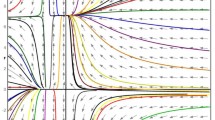Abstract
Exploitation of biological resources and the harvest of population species are commonly practiced in fisheries, forestry and wild life management. Estimation of maximum harvesting effort has a great impact on the economics of fisheries and other bio-resources. The present paper deals with the problem of a bioeconomic fishery model under environmental variability. A technique for finding the maximum harvesting effort in fluctuating environment has been developed in a two-species competitive system, which shows that under realistic environmental variability the maximum harvesting effort is less than what is estimated in the deterministic model. This method also enables us to find out the safe regions in the parametric space for which the chance of extinction of the species is minimized. A real life fishery problem has been considered to obtain the inaccessible parameters of the system in a systematic way. Such studies may help resource managers to get an idea for controlling the system.
Similar content being viewed by others
References
Alvarez L H R 1998 Optimal harvesting under stochastic fluctuations and critical depensation;Math. Biosci. 152 63–85
Alvarez L H R and Shepp L A 1998 Optimal harvesting of stochastically fluctuating populations;J. Math. Biol. 37 155–177
Bhattacharya D K and Begum S 1996 Bioeconomic equilibrium of two species system 1;Math. Biosci. 135 111–127
Brauer F and Soudack A C 1981 Coexistence properties of some predator prey systems under constant rate harvesting and stocking;J. Math. Biol. 12 101–114
Chattopadhyay J, Sarkar Ram Rup, Fritzsche-Hoballah Maria Elena Turlings, Ted C J and Bersier Louis-Felix 2001 Parasitoids may determine plant fitness — a mathematical model based on experimental data;J. Theor. Biol. 212 295–302
Chaudhuri K 1986 A bioeconomic model of harvesting a multispecies fishery;Ecol. Model. 32 267–279
Chaudhuri K 1988 Dynamic optimization of combined harvesting of a two species fishery;Ecol. Model. 32 267–279
Clark C W 1990Mathematical bioeconomics: The optimal management of renewable resources (New York: John Wiley)
Dai G and Tang M 1998 Coexistence region and global dynamics of a harvested predator prey system;Siam. J. Appl. Math. 58 193–210
Danilina N I, Dubrovskaya N S, Kvasha O P and Smirnov G L 1988Computational mathematics (Moskow: Mir Publishers)
Dimentberg M F 1988 Statistical dynamics of nonlinear and time varying systems (New York: John Wiley)
Gause G F 1935La Théorie Mathématique de la Lutte pour la Vie (Paris: Harmann)
Hoel P G, Port S C and Stone C J 1993Introduction to stochastic process (Boston: Houghton Mifflin Company)
Horsthemke W and Lefever R 1983Noise induced transitions (Berlin: Springer-Verlag)
Laloe F 1988 Un modèle global avee quantité de biomasse inaccessible liée aux conditions environnemetales. Application aux données de la pêche ivoiro ghanéenne de Sardinella auritra;Aquat. Living Resour. 1 289–298
Laloe F and Samba A 1991 A simulation model of artisanal fisheries of Senegal;ICES Mar. Sci. Symp. 193 281–286
Laloe F, Pech N, Sabatier R and Samba A 1998 Model identification for flexible multifleet-multispecies fisheries: a simulation study;Fisheries Res. 37 193–202
May RM 1973 Stability in randomly fluctuating deterministic environments;Am. Nat. 107 621–650
May R M 1975Stability and complexity in model ecosystems (Princeton: Princeton University Press)
McNamara J M, Webb J N and Collins E J 1995 Dynamic optimization in fluctuating environments;Proc. R. Soc. London B. 261 279–284
Pella J J and Tomlinson P K 1969A generalized stock production model;Bull. IATTC 13 419–496
Sarkar R R, Chattopadhyay J and Bairagi N 2001 Effects of environmental fluctuation in an eco-epidemiological model of Salton Sea;Environmetrics 12 289–300
Schaefer M B 1957 A study of the dynamics of the fishery for yellowfin tuna in the Eastern Tropical Pacific Ocean;Bull. IATTC 2 247–285
Uhlenbeck G E and Ornstein L S 1954 On the theory of Brownian motion; inSelected papers on noise and stochastic process (ed.) N Wax (New York: Dover)
Author information
Authors and Affiliations
Corresponding author
Rights and permissions
About this article
Cite this article
Sarkar, R.R., Chattopadhayay, J. A technique for estimating maximum harvesting effort in a stochastic fishery model. J Biosci 28, 497–506 (2003). https://doi.org/10.1007/BF02705124
Received:
Accepted:
Issue Date:
DOI: https://doi.org/10.1007/BF02705124




